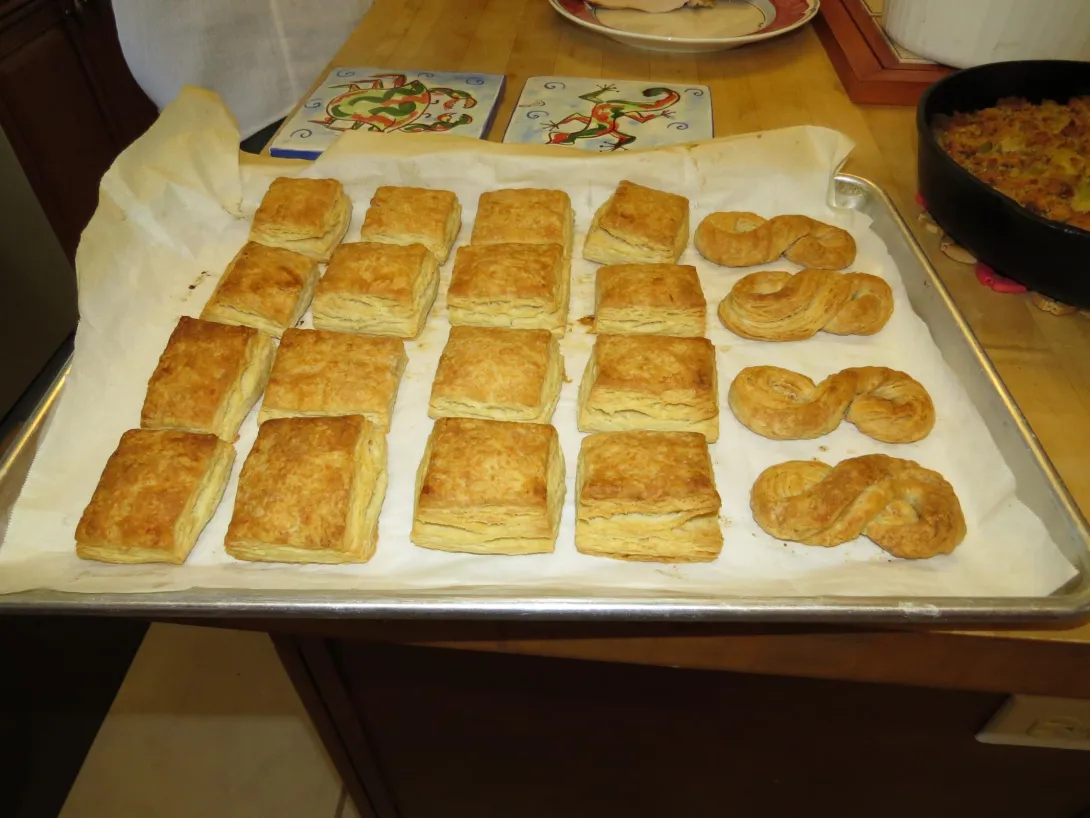
I couple of months ago I came across a recipe for the "Ultimate Flaky Buttermilk Biscuit" in "Cook's Illustrated" Sept-Oct 2015). I have tried this recipe and find it excellent. I made one main change in the recipe to make a thinner biscuit and I bake the trimmings rather than throw them away. Here is the recipe and pictures of the results.
Biscuits, Ultimate Flaky Buttermilk
3 1/2 cups (15 oz.) all purpose flour (King Arthur preferred)
4 tspn. double acting baking powder
1/2 tspn. baking soda
1 tspn salt (1 1/2 tspn if butter is unsalted)
(optional 2 Tbs sugar)
2 sticks (1/4 lb each) butter
1 1/4 cup (10.8 oz,) chilled buttermilk
Place refrigerated butter in the freezer for 30 minutes; do not freeze hard. Preheat oven to 400°F.
Mix thoroughly the flour, salt, baking powder, baking soda, and the sugar (if used). Coat the sticks of butter with flour. Using a box grater with large holes, grate 7 tablespoons of each stick of butter directly into the flour mixture. Place the remaining 2 tablespoon of butter into a dish for melting it . Gently toss the grated butter with the flour mixture.
Add the buttermilk to the flour mixture and fold it into the flour mixture. The mixture will look dry and crumbly. Transfer the mixture to a floured work surface and dust with flour. With your floured hands and a bench scrapper, shape the dough into a rough 7-inch square. With a rolling pin, roll the dough into a 12 by 9 inch rectangle. During this rolling, and during future rollings, turn the dough over at the halfway point, because the top will elongate more than the bottom. Fold the dough into thirds as you would a business letter, using your bench scraper and a spatula to release the dough from the work surface.
Again roll the dough into a 12 by 9 inch rectangle and fold the dough into thirds as you would a business letter. Let the dough rest in the refrigerator for ten minutes after the second and the fourth rolling and folding procedure. Do a total of five rolling and folding procedures.
By the fifth time the dough will appear smooth After the fifth roll and fold, roll the dough into to a square 8 1/2 inch by 8 1/2 inch*. Cover the dough with a sheet of plastic wrap and refrigerate it for 30 minutes. After thirty minutes transfer the dough to a floured cutting board, and with a floured, sharp chef’s knife, trim off 1/4 inch from each side and discard the trimmings. Cut the dough into nine equal squares of dough (2 2/3 inch on each side). Melt the reserved butter and brush the tops of the dough with it. Freeze the raw biscuits for an hour or more before baking. The raw biscuit dough may be frozen for as long as two weeks.
Bake the still frozen dough in the 400°F oven until the tops are a golden brown, 22 to 25 minutes. (Bake on parchment paper to prevent the bottoms from becoming too brown.)
*Note: If you prefer a smaller and thinner biscuit, you may do the final rolling to a square of 9 1/2 inches on a side, refrigerate for 30 minutes, trim off 1/4 inch on each side, and cut into sixteen biscuits, 2 1/4 inches on each side. I make the edge trimmings into figure eights (inifinity symbols0 and bake.
Modified from Andrew Janigian, Cook’s Illustrated, Sept-Oct 2015.
Those look great! Thanks for sharing.
Regards,
Ian
dough flour and take 1 C of the flour and 3/4 C of the buttermilk and 20 g of starter, mix it and put it on the counter overnight. Let the cut biscuits rise for an hour after making them 1" thick and you have my SD biscuit recipe. There you go.
Love these biscuits Ford!
Thank you for the sourdough version.
Ford
and you did most of the work of writing it down for me - Thanks. You have fine timing Ford!
Would you mind telling me the altitude where you bake? At 6100' I find I have to reduce the baking powder/soda from most recipes that work at low elevations.
I live in Raleigh NC. The altitude here is about 500 feet above sea level. The biscuits in the picture were baked in Sarasota FL where the altitude is about 50 feet above sea level.
Ford
I first came upon this technique, as a test baker for Peter Reinhart's "Artisan Bread Every Day" It was a very good recipe that was adopted and published by others as their own. I would encourage you to look into the original source as it has variations as well
Someone is always reinventing things. this recipe is no exception. I make no claims for originality. The techniques used are well known. This recipe does work and anyone is free to modify it further to their liking.
Ford
Don't have anything more to add at this time. :)